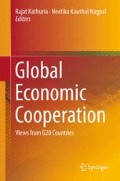Abstract
The paper analyzes various correlates of food security, viz. availability, access, utilization and stability in countries of Sub-Saharan Africa, South Asia and Latin America. Econometric estimates, based on pooled data (1990–2012 for over 40 countries), indicate that while regional variations do exist, nevertheless, broad conclusions can be drawn in terms of determinants of food security. While increases in GDP per capita, as well as its growth; improvement in infrastructure, food production, and access to better drinking water reduce both undernutrition, and the depth of food deficit significantly, food inflation (as also its volatility) has a significant adverse effect on food security. Also, increase in food imports as a percentage of total merchandize exports, in general, has a negative (though non-significant) impact. Given that access to healthy food is a basic human right, steps need to be taken to build resilience of the poor. It is in this context that the paper concludes from a broad policy perspective.
Access this chapter
Tax calculation will be finalised at checkout
Purchases are for personal use only
Notes
- 1.
World Food Summit goal: halve, between 1990–92 and 2015, the number of undernourished people.
- 2.
Millennium Development Goal 1, target 1C: halve, between 1990 and 2015, the proportion of people who suffer from hunger.
- 3.
However, this may be contrasted with efforts made by some of the African countries which have done extremely well in meeting these targets. For instance, Ghana, Malawi, Ethiopia, Mali, Niger and Nigeria achieved these targets by 2008.
- 4.
The Global Food Security Index (GFSI) is a comprehensive assessment of the drivers of food security. The index analyses the issue across three internationally designated dimensions: affordability, availability and utilization-the last of which the Economist Intelligence Unit calls “quality and safety”. The three issues of food security are addressed for a set of 105 countries, constructed from 25 unique indicators. It is a dynamic, qualitative, and quantitative benchmarking model, which adjusts for the monthly impact of global food prices. Three category scores are calculated from the weighted mean of underlying indicators and scaled from 0 to 100, where 100 represents most favourable. The overall score for the GFSI (from 0 to 100) is calculated from a simple weighted average of the category and indicator scores. The category weights are: 40, 44 and 16 % respectively for affordability, availability and quality and safety. The indicator scores are normalised and then aggregated across categories to enable a comparison of broader concepts across countries. The indicators where a higher value indicates a more favourable environment for food security-such as gross domestic product per capita or average food supply-have been normalised on the basis of:
$$ {\text{x}} = \left( {{\text{x}} - {\text{Min}}\left( {\text{x}} \right)} \right)/\left( {{\text{Max}}\left( {\text{x}} \right) - {\text{Min}}\left( {\text{x}} \right)} \right) $$where Min(x) and Max(x) are respectively, the lowest and highest values, in the 105 economies for any given indicator. The normalised value is then transformed from a 0–1 value to a 0–100 score to make it directly comparable with other indicators. Data for the quantitative indicators are drawn from national and international statistical sources. However, some qualitative indicators have been created by the EIU specifically for this index, based on information from development banks, government websites, and range of surveys.
- 5.
Presence of food safety net programs is a qualitative indicator that measures public initiatives to protect the poor from food-related shocks. This indicator considers food safety net programs, including in-kind food transfers, conditional cash transfers (i.e. food vouchers), and the existence of school feeding programs by the government, NGO, or multilateral sector. It takes a value between 0 and 4.
- 6.
For details, refer to Chap. 7 by Simrit Kaur and Harpreet Kaur in the existing edition of the book.
References
FAO (2011) The State of Food Insecurity in the World 2010: How Does International Price Volatility affects Domestic Economies and Food Security? Rome: FAO. http://www.fao.org/docrep/013/i2050e/i2050e.pdf
FAO (2012) Food Security Indicators. FAO Statistics. http://www.fao.org/economic/ess/ess-fs/ess-fadata
FAO (2013) The State of Food Insecurity in the World. The multiple dimensions of food security food security? Rome: FAO. http://www.fao.org/docrep/018/i3434e/i3434e.pdf
GFSI (2012) Global Food Security Index, The Economist Intelligence Unit’s GFSI
GFSI (2013) Global Food Security Index, The Economist Intelligence Unit’s GFSI
Global Hunger Index (2013) The challenge of hunger: Building Resilience. International Food Policy research Institute
HLPE (2011) Price volatility and Food Security. A report by the High Level Panel of Experts on Food Security and Nutrition of the Committee on World Food Security, Rome, 2011
Ivanic M, Martin W, Zaman H (2011) Estimating the short-run poverty impacts of the 2010–11 surge in food prices. World Bank Policy Research Working Paper Series, 5366
Willenbockel D (2011) Exploring Food Price Scenarios Towards 2030 with a Global Mutliregional Model. Oxfam Research Reports. http://www.oxfam.org/sites/
World Bank’s World Development Indicators (WDI) available online at: http://data.worldbank.org/data-catalog/world-development-indicators
World Bank (2013) World development indicators 2013. World Bank, Washington, DC. doi:10.1596/978-0-8213-9824-1
World Food Summit (1996) World Food Summit Plan of Action, paragraph 1. In: Rome Declaration on World Food Security and World Food Summit Plan of Action; World Food Summit, 13–17 Nov 1996, Rome, Italy. Rome, FAO
Author information
Authors and Affiliations
Corresponding author
Editor information
Editors and Affiliations
Appendix
Appendix
Rights and permissions
Copyright information
© 2016 Indian Council for Research on International Economic Relations
About this chapter
Cite this chapter
Kaur, S., Kaur, H. (2016). Determinants of Food Security in Sub-Saharan Africa, South Asia and Latin America. In: Kathuria, R., Nagpal, N. (eds) Global Economic Cooperation. Springer, New Delhi. https://doi.org/10.1007/978-81-322-2698-7_6
Download citation
DOI: https://doi.org/10.1007/978-81-322-2698-7_6
Published:
Publisher Name: Springer, New Delhi
Print ISBN: 978-81-322-2696-3
Online ISBN: 978-81-322-2698-7
eBook Packages: Economics and FinanceEconomics and Finance (R0)

